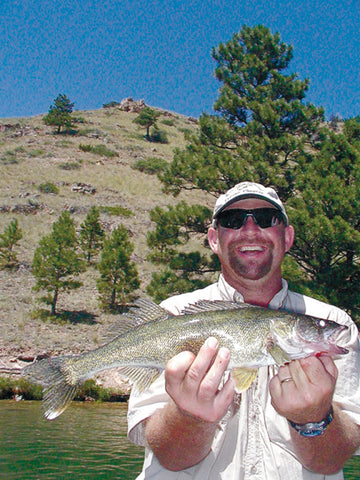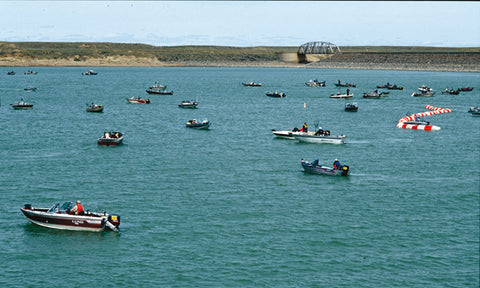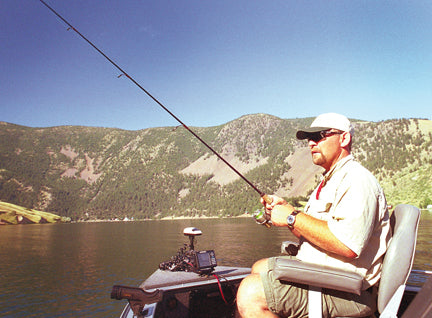The Eyes Have it: Walleye Fishing in Montana

Walleye fishing on Holter Lake near Helena. Dave Reese photo

Walleye fishing in a tournament at Fresno Reservoir near Havre. Dave Reese photo

Walleye fishing on Holter Lake near Helena. Dave Reese photo
By DAVE REESE, Montana Living
Aside from bass, there's probably no single fish that draws such enthusiasm as walleye. In Montana, a core group of walleye anglers pursue their quarry with zeal.
For people like Bob Hickey, president of the Flathead chapter of Walleyes Unlimited, walleye fishing is not just a pastime; it's a passion.
Hickey became hooked on walleye fishing on a trip to the Midwest and since 1994 he has made walleye fishing his competitive sport. Hickey competes in four to five tournaments a year around Montana, and with tournaments offering up to $10,000 to the winner, the excitement gets his blood going. "It's a noncontact sport," Hickey says. "But I can't say it's for the money. I'm not making any boat payments or anything with the winnings."
Walleye tournaments are among the fastest-growing fishing competitions.
"Any time there's money involved, people are interested," Hickey says. "It really challenges you to put two good days together to compete."
The Walleye Festival on Canyon Ferry offers one of the top purses in the state, with $10,000 offered.
Fishing for walleye also gives him the chance to reunite with his friends across the state and spend time with his family. Hickey fishes often with his sons and his wife, and he and his son Bobby were the Montana Anglers of the Year in 1998. Bob Hickey is now in 11th place in the state out of 611 anglers on the Montana walleye tournament circuit.
The scarcity of walleye in western Montana doesn't keep anglers like Hickey from going after them almost every weekend. Part of the reason he started fishing tournaments was to learn different lakes and techniques for catching walleye. "You can't beat on-the-water study," Hickey said.
The state of Montana recently began work on the $12 million warm water fish hatchery at Fort Peck that will grow walleye, pike, bass and others.
With the construction of a new warm-water hatchery in Fort Peck, walleye fishing will be a popular family sport for years to come.
Because of concerns about how warm water fish would impact threatened species like bull trout and species of special concern like cutthroat trout, the planting of warm water species is not allowed in western Montana. The only walleye in the Flathead are small pockets of fish illegally introduced to area lakes.
But despite the fact there may never be state-promoted walleye fishing on the west side of the Continental Divide, the species seems to be growing in popularity. The Flathead Chapter of Walleyes Unlimited, for example, in its short two-year existence, has attracted 85 members.
The walleye is known not only for its fight but also for its appeal on the table. Perhaps that is why the fish is so sought after.
"From the standpoint of table fish, it's the prime one," says Frank Danner, an avid walleye fisherman and secretary of the Flathead walleye chapter.
A member of the perch family, walleyes have a tasty white, flaky meat.
They are darn good to eat, but many of the Walleyes Unlimited die-hards practice "catch and release" exclusively. Could it be that anglers are just attracted to the scenic reservoirs where walleye are found? Possibly, but most walleye anglers are rather intense and unlikely to be distracted by scenery. It's hard to understand and explain, but I propose it's that unmistakable walleye "attitude" that hooks anglers just as it captures the interest of fisheries biologists.
From a biologist's viewpoint, there probably isn't a more challenging fish to manage, says Dave Yerk, a fisheries biologist in Choteau, Montana. "Walleye are just plain unpredictable," he said.
Trying to keep a walleye population in sync with their prey is maddening, at best, for a fisheries biologist. The walleye is a top predator. To maintain a healthy fishery it is important to balance walleye numbers with forage fish numbers. But that balance often changes year to year, depending on the spawning success of both walleye and their prey.
Walleye are prolific when the conditions are right, which in any given year can be related to weather, water temperature, reservoir elevations, and a seemingly infinite number of other variables. These same factors influence production of prey species, but not necessarily in the same way they impact the walleye. But, even with this understanding, biologists have little control over most of these variables.
Like any fish, catching them is different than fishing for them.
"They can come easy or they can come hard," says Danner. "There's almost a mystique about walleyes, but if you put some time and effort into them, you can find a way to catch them."
Hardcore walleye fishermen head out to Valier, Tiber and Nelson reservoirs for their action. Fort Peck Lake is the mecca of walleye fishing in Montana, with Fresno Reservoir near Havre also seeing a lot of action.
You won't a group of fishermen as addicted to fishing as walleye anglers. Jack McGuire of Bigfork caught his first walleye on a trip to the Midwest in 1985 and "it was all over," he said. "I was hooked from then on. I wish I'd have done it 40 years ago. It gets addictive."
He enjoyed it so much that he went pro. One day while watching a walleye program on television, he told himself "I can do that," and he began his journey on the Professional Walleye Tour. McGuire fished with some of the top names in the country, and came away with a couple of top-10 finishes before retiring. He traveled more than 8,000 miles a year competing, but the travel required to fish walleyes was just too much, he said, so he retired.
McGuire said fishing for walleyes is more like hunting. While a bass will tend to hold up on structure, schools of walleye can travel 30 miles in a day.
"They are an extremely smart fish," McGuire said. Boat control is extremely important in fishing walleye. McGuire's walleye boat has three motors on it, one for each specific job. A backtrolling motor allows the boat to be run backward, allowing better control of the bow.
Walleye fishing takes an entirely different setup than what you'd find in a western Montana lake angler's tackle box.
For instance, the Lindy rig is a very popular way of finding walleye. A Lindy rig consists of a sinker, leader of line, two-way barrel swivel and a hook. The types of sinkers that are generally used are walking, Texas bass casting, egg, and bottom bouncer. The hook can be a multitude of sizes, shapes, and colors, from a basic No. 2 Aberdeen hook to a floating jig head. It can be trolled, drifted, dragged or cast out of the boat. Trolling with bottom bouncers and Lindy rigs is one of the best way to locate walleye. Once you find them with this method, you turn to jigging.
"It's a game," McGuire said. "You've got to do your homework."



